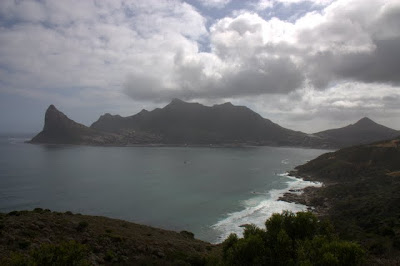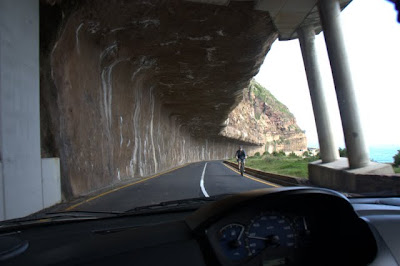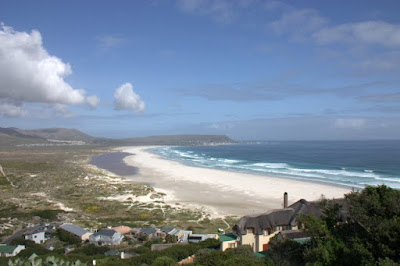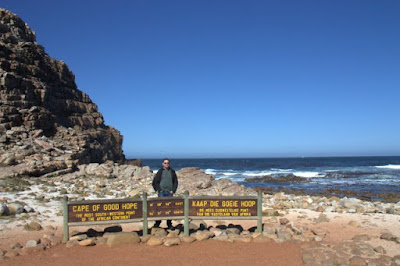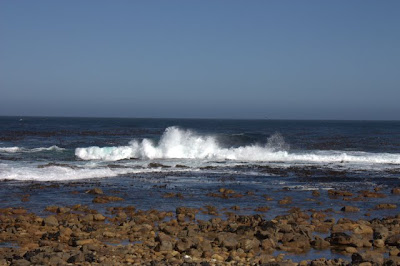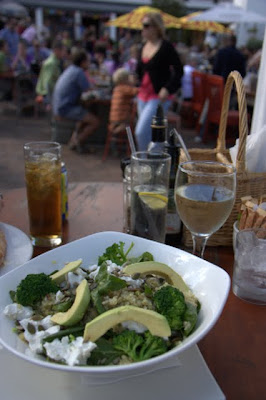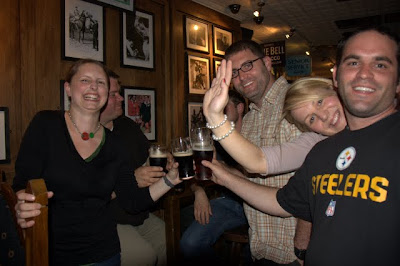Scenes from Cape Point
One of the highlights of Cape Town is not in Cape Town itself, but on Cape Point, the peninsula that juts into the Atlantic and Indian Oceans. I loved both of the day trips we spent exploring Cape Point. The scenery on Cape Point is amazing: beaches, cliffs, mountains, wild flowers.
We hiked up to the lighthouse on Cape Point for amazing views, and stood at the southwestern-most point of Africa at the Cape of Good Hope.
I saw a guesthouse at which I want to stay if I am ever on Cape Point again.
Each day we visited, we ate lunch at a different farm and craft village, where we drank local wine, ate organic food, and soaked up the sunshine. It was late August – the equivalent of late March at home – and spring was in the air.
All of this, not to mention all of the animals we saw…coming soon!
European Wrap-up, Rants and Raves
When we first arrived in Europe on March 31, it felt very much like a foreign land. We spent many days alternating between a state of confusion and wonderment. We were only supposed to spend three months in Europe, but ended up staying just shy of four months. Some time during our four month stay – probably when we escaped back to Spain after having a tough time in Morocco after getting ill – we came to view Europe as more familiar than foreign, no matter what the country or the language. Sure, every country is unique, but every country we visited is fundamentally Western. Once we adjusted to travelling somewhere that we couldn’t speak the language – which admittedly is still difficult and frustrating at times – everything else fell into place.
We traded going to Europe for going to South America, which we’ll save for the future. Going to Europe definitely ate into our travel budget much, much more than if we had gone to South America, but it was worth it. We had never been to Europe before. The European countries have had and do have such a dominant influence on the rest of the world that it would be difficult for us to understand other countries and cultures without first experiencing Europe itself. We tried to minimize costs by going to countries that are rumored to be less expensive – Spain, Portugal, Czech Republic, Slovenia, Croatia, Hungary, and Poland. None of those countries were as cheap as we hoped, but costs are definitely lower than some European countries. We did slip in a few countries with higher costs – France, Germany, Belgium, Ireland, and Northern Ireland – but tried to counterbalance those costs in France and Germany by staying with friends and in Germany and Belgium by only staying a short time. If you missed it, I posted about our average daily cost to travel through Europe yesterday.
Even with four months, we barely scratched the surface of Europe. I know we will be back someday – I still need to eat my way through Italy after all. As we move on to the rest of the world, I thought I’d close out our experiences by sharing our rants and raves about Europe:
Raves
- Canine freedom. Dogs lead a much better life than in the United States. They seldom are leashed and typically have the freedom to roam courtyards, restaurants, and beaches.
- Lax liquor laws. Particularly because we live in Pennsylvania, one of the states with the strictest and asinine liquor laws (god forbid you buy a beer in a grocery store or drink outside in public!), we appreciated the freedom of Europeans to have a drink essentially whenever they want where ever they want.
- Plethora of bakeries. Even outside of Paris, where they elevate baking to an art form, much to the delight of my sweet tooth, bakeries can be found on almost every street. Besides providing constant dessert, the savory items, such as empanadas and the like, made for cheap eats.
- Free time. While it endlessly confused as to why no one ever appeared to be working, Europeans’ love of sitting around in cafes and in parks, doing nothing, fit in well with our new hippie, jobless lifestyle. Once we return to the States and re-join the “real world,” I need to remember to incorporate in more time to perfect the art of doing nothing. I think it does wonders for the soul.
- Runaway trains. The ease of train travel in Europe is amazing. Small towns, big cities, new countries: you can reach almost every place in Europe by train. It is hard to suppress the urge to keep on rollin’ when it is as easy as going to the center of town and hopping on board.
- Urban love. Most European cities have compact city centers. Life is centered in the middle, and radiates out from there. There are no such thing as a true suburb in Europe. There is just the city, the outskirts, and the country. The cities are full of life. This is most likely related to a corollary love: ease of getting around. Most European cities can be traversed by foot or by amazingly efficient public transit systems. Transit for the masses in Europe is the polar opposite of the Pittsburgh Port Authority. Most cities have subways or trams. Even buses are better: most have digital read-outs at the bus stop indicating how long you’ll be waiting for the next bus. Having a car in not necessary in many countries, and in fact, can even be a hindrance in many of the cities.
- Blurred edges of different cultures. I love that crossing borders is as easy as crossing into different states. Because each country has its own language, food, and customs, it never lost its luster to change countries. Most jarring, and exciting, was the flights we took, which meant we switched from Spanish culture to Czech culture in the same day or, later, from Polish culture to Irish culture. But just as interesting was travelling overland, where you could watch separate cultures swirl together, always retaining their own subtle differences.
- European green. Throughout Europe, we spotted solar energy, windmills, and recycling bins, which made my tree-hugger heart happy.
- No need for a DVR. Though it is rare that I watch a commercial at home anymore due to the world’s greatest invention, you still can’t avoid them, such as during a live sporting event. We met a German woman living in Portugal who just could not wrap her head around the number of commercials in the United States. After watching television in Europe, I’m with her. It is nice, however, to have an occasional commercial during a sporting event for a bathroom or snack break. No need for one after practically every play, like American football, but I don’t have the undivided attention span required to watch European football!
- Beautiful things all around. Between the architecture and green spaces, your eye always has somewhere to linger.
- Disappearing taxes. If I had to pay as much tax as the Europeans do, I wouldn’t want to see it all broken down either. Prices in Europe already comes with the tax included, which makes it easier to figure out how much damage you are doing to your wallet.
- No tip jars for performing your job. Tipping culture in the United States can get out of control at times. Tip jars in Europe are a rare sight. Waiters and waitresses are paid better than their U.S. counterparts, so tips in Europe are either nonexistent or drastically reduced.
- Living life outside. One of the worst things about working is shuffling between a dark, stuffy office and a dark, stuffy restaurant for lunch on a nice, sunny day. There is never enough outdoor seating at home, but this is not a problem in Europe. People live their lives outside: with open, screenless windows; at outdoor cafes and restaurants; in public squares and parks.
- Markets. It is typically not hard to find farmers and artisanal vendors selling their wares in a market.
- No unnecessary 9.99s. The jig is up; we all know 9.99 is really basically $10. The Europeans don’t try to fool us and just charge flat amounts.
- Casual breeziness. Even in fancy Paris, women always looked so pulled together in a casual, understated way. No sweatpants in public here.
- Appreciation of eating and drinking. I’ve alluded to this above, but Europeans in general have a sincere appreciation for food and drink. My taste buds were happy there.
Rants:
- Smoky hazes. Although some countries are getting on board with smoking bans in public buildings, the smoking habit in Europe is alive and well.
- Tiny drinks. This was particularly Sean’s pet peeve. The drinks in Europe are absurdly tiny, leaving us constantly thirsty. We agree that supersizing is excessive, but how do they get away with charging 3 or 4 euros for a 6 oz. coke?
- Is this the Sahara desert or something? As a corollary to the rant above, contributing to our constant thirst was the fact that very, very few restaurants served tap water and insisted upon making you pay for fancy – and often tiny – bottled water. My favorite is when we would be told that they flat out did not have tap water. Right. If we would get tap water, the chances of getting a refill was slim to none. Related is the Europeans’ love of sparkling mineral water and my corresponding hatred of the same. Sean still laughs at the memory of me uncouthly spitting out mineral water on the sidewalk on a 90 degree day when we couldn’t figure out, for the second bottle in a row, what meant still water in Hungarian.
- Lack of customer service. Although our pocketbooks liked our love of tipping less, this all too often was accompanied by little desire to please the customer. See note about no refills of water, above. We quickly understood the cultural difference of needing to ask for the check, but never got used to being completely ignored once the food arrived.
- Sleeping like old people. We probably had one queen bed the whole time we were there; otherwise it was two twins pushed together. Although, I think Sean actually secretly liked having more room in a bed to himself.
- Runaway shower heads. I cannot stand the hand-held shower head. When there was a holder than worked, they weren’t that bad, just less water pressure than I’m used to. The rest of the time, I never could figure out where you are supposed to set the shower head whenever you did anything else, such as wash your hair. I’ve squirted many ceilings, walls, and my eyes when the shower head, ever so carefully laid in a resting place to soap up, suddenly surge with water.
- Confounded locks. While the old-fashioned keys are cool to look at, use of them befuddled me 9 times out of 10.
- Lack of air conditioning. I know that old buildings make retrofitting them for air prohibitively expensive, and excessive use of air is bad for the environment, but there is NO respite from heat in certain cities in the dead of summer – not even in the grocery store or restaurants, two notoriously freezing places at home. When there is air, it is usually a room unit, extremely undersized, that chugs weakly in a huge space with open doors and windows.
- Tiny, tiny, tiny Speedos. Not an original rant, I know, but really – why?
- Subpar chiclet. When I was an office drone, I chewed an excessive amount of gum. I haven’t completely broken the habit, but the tiny, hard pieces of gum will likely help. Where is the spearmint Orbit when you need it?
- Never having exact change, yet always having a ton of coins. Without fail, every time we tried to pay for something in cash, the cashier would declare our tender to be too large and request exact change. Nothing is ever good enough. Once I tried to pay for a 19 euro bill with a 20 and was rebuffed and interrogated about the change in my possession. Yet, because of the 1 and 2 euro coins, we were constantly weighed down. On a related note, if I had a euro for every time the machines at places that purportedly accepted credit cards was mysteriously “broken,” I wouldn’t need to use credit cards at all.
- Paying crazy taxes as a tourist. I know someone’s got to pay for all of the fabulous things in Europe, and you can sometimes get a refund on big-ticket purchases, but ouch! No wonder they bury all of the taxes.
- Graffiti. For some reason, many of the beautiful things in Europe are covered in ugly, messy graffiti. It makes me sad such beautiful, historic items are ruined.
- 80s on steriods. For the life of me, I cannot understand why anyone would wear those baggy, droopy pants that sag in the butt and crotch and taper at the ankles. They didn’t look good on MC Hammer, and not even skinny European girls can pull them off now. Please, for the love of God, tell me that these have not made an appearance in the United States. Please.
So there you have it! Traveling in Europe is a fabulous experience. I can’t wait to go back someday, but it was great to move on after spending so much time there. Stay tuned for posts about South Africa and Jordan in the weeks to come, then it is Asia time!
Cheers to Ellen
Sean’s going away party from work was a combo lunch/happy hour that began around 1:00 p.m. and ended with a rousing duet of Take This Job and Shove It at a karaoke night at a dive bar in Millvale. We made a promise to Ellen, a friend of Sean’s from work, that night. Ellen probably thought we forget, but fear not, Ellen, we remembered. Ellen requested that we toast to her in Ireland, and toast we did. Only there was one small problem. We saved the toast until other current and former co-workers joined us in Ireland. In our last night with the group in Kilkenny, Sean, Matt, Jason and I prepared to gather round for a toast to Ellen, complete with a picture to document the event. What we didn’t count on was two very drunk Irish girls interrupting our toast:
The two girls lept in front of the camera and inserted themselves into our toast. So, Ellen, cheers to you, from Sean, Matt, Jason, me, and two random drunken Irish girls.
On Craic and Irish Phrases
It was immediately apparent that the Irish love to talk. And not just, hi, how are you, where you from types of exchanges, but actual, real conversations. (Although the economy and the weather were still definitely the most popular topics). After months of having only brief stilted conversations in whatever English someone could muster, it was refreshing just to shoot the breeze.
The Irish even have a name for what Americans would call b.s. The Irish call it craic, which I understand to mean the art of pure conversation just for conversation’s sake.
Some touristy pubs try to capitalize on the Irish love of craic. Anytime I saw a sign saying Live Traditional Music Every Night! Lively craic here! I knew that was not where we wanted to go. Something tells me that you can get the best craic in places that don’t advertise it.
You never know where you’ll get your craic fix in Ireland. For me, the best extended craic fix was in Doolin. Doolin is a tiny village, by the sea, at the outer point of County Clare. It is reportedly known for its local traditional music. The guidebooks report that there are only three pubs in the village, but a local told us there are actually four.
We heard that Gus O’Connor’s was the best, but we never made it there. We started at one in the upper end of town and listened to the band there for a while. Matt and Tony left ahead of us to head to Gus O’Connor’s while the rest of us finished our drinks. Knowing Matt and Tony like the four of us do, we had the foresight to stop in McGann’s, the pub right down the road, before walking to the other side of town. Sure enough, there were Matt and Tony, who had decided to stop for a quick pint before heading up the road. Except we never headed up the road, and somehow a quick pint ended turned into Tony, at 1:00 a.m., trying to pay the bartender 50 euros to keep the bar open.
But I’m jumping ahead of myself. When we got in the pub, the boys started watching the band. For some reason, Danielle and I hung back by the bar, and somehow got wrapped up in conversations with a colorful cast of characters. I started talking to a man named Patrick. Patrick introduced me to a dairy farmer (who was amused by my interest in his work, but I had lots of burning questions about the cows). Somewhere along the line, I started chatting with a guy from Dublin, while Danielle carried on talking to Patrick. At some point, a very drunk Irish/Australian guy jumped in, and the craic just continued from there.
Before we knew it, the music was over, and the bartender locked the doors and began pulling the curtains. Best we can figure out, once you are in, you are in, and you can continue drinking in a bar as late as the bartender keeps serving. At some point, they try to kick you out. If you’re Tony, that’s when you get out your wallet, tell Matt to get two drinks and give the bartender the rest if they’ll keep serving.
Before getting the boot, Danielle and I were talking to a woman from the band (we think, because we never really saw the band), and she declared that we must have our pictures taken with the owner. She grabbed my camera from my hand and told us to smile, but then realized that she had the camera turned around to point at herself! She then insisted that Danielle and I take our picture with her. She thrust my camera towards Matt, who happened to be standing there. Here, the woman barked at Matt. Take our picture! Being the usual smartass that he is, Matt started taking pictures of the ceiling instead of us. The woman grabbed the camera out of his hand and exclaimed, Oh, for fuck’s sake!
Thus, sometime between 1 to 2 a.m. in Doolin (who can be sure?), our new Irish catchphrase was born. Although in general we tried to keep our fake Irish accents to a minimum on this trip, it really is necessary to say this with as much brogue as you can muster.
It is a lovely day for a…Budweiser?
One does tire a bit of Guinness if you drink it almost every day for three weeks in a row, so I was excited to try an Irish microbrew at a gastropub we visited in Dublin. There is where I had my first Hooker. Galway Hooker is a pale ale that is in serious contention to be one of my favorite beers of all time. Unfortunately for me, it is only brewed in small quantities and served on draft in a couple of pubs in Ireland only.
While I didn’t think that the Irish drank Guinness ALL of the time, it never occurred to me that it wouldn’t be what the Irish drank MOST of the time. It didn’t take us too long to notice that Guinness was not the only drink that people were drinking. With due apologies to the Coors-loving Texan we met in Gort, Ireland, we were horrified that American beer-flavored water was often featured on tap. With some many delicious Irish beers, we weren’t sure why the Irish felt the need to stray. Everywhere you went, Budweiser had big ads about its ice cold beer chilled below zero. If the best thing you can say about your beer is that it needs to be below freezing to make it taste okay, pardon me if I don’t rush to the bar to try some. Strangely, we noticed the ads for Harp featuring the ice chilled temperature as its selling point. I tried a Harp and was disappointed. I’m not sure if it tastes better at home in relation to other options, or if the beer is formulated differently, or if it has been a long time since I had a Harp, but it was not great. Besides Guinness, Smithwick’s is featured on almost every tap. Our friend Matt is fond of Kilkenny, and we saw that from time to time. But what people were drinking most frequently was Carlsburg, a mild Danish lager, or, gasp, Budweiser.
We decided to get to the bottom of the Irish beer drinking habits by quizzing the bartender at the gastropub in Dublin. Dave, the bartender, told us that Guinness is no longer the most popular beer in Ireland, and that young people don’t drink Guinness. He said that the only people who drink Guinness in Ireland are the older people and the tourists. He said no one drinks Harp or Kilkenny, and that most people drink Carlsburg or some other lager. According to Dave, Guinness is developing a lighter lager to try to recapture some of the market. He said that Ireland used to have lots of microbrews, but the Queen got rid of most of them. Now, the microbrews are trying to make a comeback.
I know. It was a shock to me, too. I mean, we are talking about a country where every – and I mean EVERY – pub has a Guinness sign out front. A city that has a bridge devoted to Guinness. Now, we decided to take Dave’s insight as a grain of salt. This is coming from one person, who happens to be a bartender in a bar featuring microbrews. On top of that, we weren’t sure whether to trust Dave or not.
We were staying in the rowdy Temple Bar section. While it was filled with pubs, most of the people frequenting them were either tourists or college students. So we asked for recommendations for a place where he and other locals would go out. Dave directed us to several bars on a street far away from the touristy center. The first bar was packed to the gills with very, very drunk college students. It was loud and obnoxious and reminiscent of the bars in the Temple Bar, except substitute annoying American music like Kid Rock for traditional Irish bands catering to tourists. We stayed for one beer, but left after a guy started throwing up at the table beside us.
Thus began a debate amongst us: was Dave messing with us by sending us to that bar? You see, he had told us that when English tourists inquired where to go out for good night life, they always sent them to the gay bars as a joke. The bar seemed at odds with his laid-back nature and his Ipod-playlist playing over the loudspeakers at the gastropub. Was this a joke on us? Is this where he sends Americans for a laugh?
We’ll never know, but the countervailing argument was that the single members of our group had inquired about the best place to meet Irish ladies and one could have their pick of drunken women at that bar. And the second bar he recommended was much more a speed: laid-back, good tunes, and not crowded. The two bars did have something in common though: practically the only ones drinking Guinness in either one was us.
After leaving Dublin, I kept my eye out. And I’d have to say Dave knew what he was talking about. While the old-timers still savored a pint of the black stuff, most people, particularly younger people, seemed to drink lagers and ciders. When quizzed about Irish drinking habits, other people concurred that Guinness is not as popular anymore and not the “cool” thing to drink. Some said it is too heavy; some said they only drink it in winter (as if there is a difference between the summer weather we experienced). According to The Internet, Guinness still is the number one selling beer in Ireland, but its market share has been decreasing over the years.
Even if everyone in Ireland does not love Guinness, I still do.
Everything you wanted to know about Irish beer, and then some:
http://en.wikipedia.org/wiki/Guinness
http://www.europeanbeerguide.net/irlbrew.htm
http://www.bootsnall.com/articles/08-08/best-selling-beers-around-the-world.html
